Spatiotemporal Modeling of the Electricity Production from Variable Renewable Energies in Germany
Abstract
:1. Introduction
2. Data
2.1. Power Plant Datasets
2.2. Applied Weather Product
2.3. Calibration and Validation Data
- Power reduction because of mutual shading of adjacent turbines (wake effect).
- Loss of power due to ice or dirt on the rotor blades of the wind turbines.
- Feed-in interruptions because of energy surpluses in the power grids.
- Switch-offs due to turbine overhauls or bat and bird protection.
3. Models
3.1. Wind Power Model
3.2. Photovoltaic Model
4. Results
4.1. Wind Power Generation
- Deviations caused by the wind speed extrapolation from 10 m to the hub height.
- The uncertainties of the weather data and the fact of hourly averaged values.
- Weather-related variations in air pressure are not considered in the model.
- The assignment of turbines to power classes with typical power curves.
4.2. Photovoltaic Power Generation
- The use of average values due to the lack of specific data for photovoltaic systems.
- The uncertainties of the weather data and the fact of hourly averaged values.
- Decrease of the power generation because of snow on the modules.
- Feed-in reductions due to energy surpluses or maintenance work.
4.3. Common Power Generation
4.4. Energy Transition Atlas
5. Conclusions
Author Contributions
Funding
Informed Consent Statement
Conflicts of Interest
References
- GWEC. Global Wind Report 2021; Global Wind Energy Council: Brussels, Belgium, 2021. [Google Scholar]
- BMWi Time Series for the Development of Renewable Energy Sources in Germany Based on Statistical Data from the Working Group on Renewable Energy-Statistics (AGEE-Stat). Available online: https://www.erneuerbare-energien.de (accessed on 5 May 2021).
- IRENA. Renewable Power Generation Costs in 2019; International Renewable Energy Agency (IRENA): Abu Dhabi, United Arab Emirates, 2020. [Google Scholar]
- Rauner, S.; Eichhorn, M.; Thrän, D. The Spatial Dimension of the Power System: Investigating Hot Spots of Smart Renewable Power Provision. Appl. Energy 2016, 184, 1038–1050. [Google Scholar] [CrossRef]
- Eichhorn, M.; Scheftelowitz, M.; Reichmuth, M.; Lorenz, C.; Louca, K.; Schiffler, A.; Keuneke, R.; Bauschmann, M.; Ponitka, J.; Manske, D.; et al. Spatial Distribution of Wind Turbines, Photovoltaic Field Systems, Bioenergy, and River Hydro Power Plants in Germany. Data 2019, 4, 29. [Google Scholar] [CrossRef] [Green Version]
- Olauson, J.; Bergkvist, M. Modelling the Swedish Wind Power Production Using MERRA Reanalysis Data. Renew. Energy 2015, 76, 717–725. [Google Scholar] [CrossRef]
- Olauson, J. ERA5: The New Champion of Wind Power Modelling? Renew. Energy 2018, 126, 322–331. [Google Scholar] [CrossRef] [Green Version]
- Gruber, K.; Regner, P.; Wehrle, S.; Zeyringer, M.; Schmidt, J. Towards a Global Dynamic Wind Atlas: A Multi-Country Validation of Wind Power Simulation from MERRA-2 and ERA-5 Reanalyses Bias-Corrected with the Global Wind Atlas. arXiv 2020, arXiv:2012.05648. [Google Scholar]
- Olauson, J.; Bergkvist, M. Correlation between Wind Power Generation in the European Countries. Energy 2016, 114, 663–670. [Google Scholar] [CrossRef]
- Ramirez Camargo, L.; Stoeglehner, G. Spatiotemporal Modelling for Integrated Spatial and Energy Planning. Energy Sustain. Soc. 2018, 8, 32. [Google Scholar] [CrossRef]
- Hawkins, S.; Eager, D.; Harrison, G.P. Characterising the Reliability of Production from Future British Offshore Wind Fleets. In Proceedings of the IET Conference on Renewable Power Generation, Hertfordshire, UK, 6–8 September 2011; p. 212. [Google Scholar] [CrossRef] [Green Version]
- Kiss, P.; Varga, L.; Jánosi, I.M. Comparison of Wind Power Estimates from the ECMWF Reanalyses with Direct Turbine Measurements. J. Renew. Sustain. Energy 2009, 1, 033105. [Google Scholar] [CrossRef] [Green Version]
- Lehneis, R.; Manske, D.; Schinkel, B.; Thrän, D. Modeling of the Power Generation from Wind Turbines with High Spatial and Temporal Resolution. EGU Gen. Assem. Conf. Abstr. 2020. [Google Scholar] [CrossRef]
- Lehneis, R.; Manske, D.; Thrän, D. Modeling of the German Wind Power Production with High Spatiotemporal Resolution. ISPRS Int. J. Geo-Inf. 2021, 10, 104. [Google Scholar] [CrossRef]
- Lehneis, R.; Manske, D.; Thrän, D. Generation of Spatiotemporally Resolved Power Production Data of PV Systems in Germany. ISPRS Int. J. Geo-Inf. 2020, 9, 621. [Google Scholar] [CrossRef]
- Thrän, D.; Bunzel, K.; Klenke, R.; Koblenz, B.; Lorenz, C.; Majer, S.; Manske, D.; Massmann, E.; Oehmichen, G.; Peters, W.; et al. Naturschutzfachliches Monitoring des Ausbaus der Erneuerbaren Energien im Strombereich und Entwicklung von Instrumenten zur Verminderung der Beeinträchtigung von Natur und Landschaft; Bundesamt für Naturschutz: Bonn, Germany, 2020. [Google Scholar]
- Becker, R.; Thrän, D. Completion of Wind Turbine Data Sets for Wind Integration Studies Applying Random Forests and K-Nearest Neighbors. Appl. Energy 2017, 208, 252–262. [Google Scholar] [CrossRef]
- Federal Network Agency Core Energy Market Data Register. Available online: https://www.bundesnetzagentur.de/EN (accessed on 30 July 2020).
- EEG-Anlagestammdaten. Available online: https://www.netztransparenz.de/ (accessed on 30 July 2020).
- Rienecker, M.M.; Suarez, M.J.; Gelaro, R.; Todling, R.; Bacmeister, J.; Liu, E.; Bosilovich, M.G.; Schubert, S.D.; Takacs, L.; Kim, G.-K.; et al. MERRA: NASA’s Modern-Era Retrospective Analysis for Research and Applications. J. Clim. 2011, 24, 3624–3648. [Google Scholar] [CrossRef]
- Gelaro, R.; McCarty, W.; Suárez, M.J.; Todling, R.; Molod, A.; Takacs, L.; Randles, C.A.; Darmenov, A.; Bosilovich, M.G.; Reichle, R.; et al. The Modern-Era Retrospective Analysis for Research and Applications, Version 2 (MERRA-2). J. Clim. 2017, 30, 5419–5454. [Google Scholar] [CrossRef] [PubMed]
- Hersbach, H.; Bell, B.; Berrisford, P.; Hirahara, S.; Horányi, A.; Muñoz-Sabater, J.; Nicolas, J.; Peubey, C.; Radu, R.; Schepers, D.; et al. The ERA5 Global Reanalysis. Q. J. R. Meteorol. Soc. 2020, 146, 1999–2049. [Google Scholar] [CrossRef]
- Bollmeyer, C.; Keller, J.D.; Ohlwein, C.; Wahl, S.; Crewell, S.; Friederichs, P.; Hense, A.; Keune, J.; Kneifel, S.; Pscheidt, I.; et al. Towards a High-Resolution Regional Reanalysis for the European CORDEX Domain. Q. J. R. Meteorol. Soc. 2015, 141, 1–15. [Google Scholar] [CrossRef]
- Frank, C.W.; Wahl, S.; Keller, J.D.; Pospichal, B.; Hense, A.; Crewell, S. Bias Correction of a Novel European Reanalysis Data Set for Solar Energy Applications. Sol. Energy 2018, 164, 12–24. [Google Scholar] [CrossRef]
- Satellite Application Facility on Climate Monitoring (CM SAF). Available online: https://www.cmsaf.eu/EN/Home/home_node.html (accessed on 18 March 2020).
- EU Science Hub-Photovoltaic Geographical Information System (PVGIS). Available online: https://ec.europa.eu/jrc/en/pvgis (accessed on 25 June 2020).
- Mueller, R.W.; Matsoukas, C.; Gratzki, A.; Behr, H.D.; Hollmann, R. The CM-SAF Operational Scheme for the Satellite Based Retrieval of Solar Surface Irradiance—A LUT Based Eigenvector Hybrid Approach. Remote Sens. Environ. 2009, 113, 1012–1024. [Google Scholar] [CrossRef]
- Pierrot, M. The Wind Power. Available online: https://www.thewindpower.net/ (accessed on 25 June 2020).
- Datasheet ENERCON E-40/5.40; ENERCON GmbH, Dreekamp 5: Aurich, Germany, 2003.
- Krebs, H.; Kuntzsch, J. Betriebserfahrungen Mit Windkraftanlagen Auf Komplexen Binnenlandstandorten. Erneuerbare Energy 2000, 12, 2000. [Google Scholar]
- Hosenuzzaman, M.; Rahim, N.A.; Selvaraj, J.; Hasanuzzaman, M.; Malek, A.B.M.A.; Nahar, A. Global Prospects, Progress, Policies, and Environmental Impact of Solar Photovoltaic Power Generation. Renew. Sustain. Energy Rev. 2015, 41, 284–297. [Google Scholar] [CrossRef]
- Krömke, F. Ertragsgutachten-PV Freiflächenanlage BEMA Halde Korbwerder, Sachsen-Anhalt, Deutschland. Available online: https://www.helionat.de/ (accessed on 31 August 2020).
- SMARD-Strommarktdaten. Available online: https://www.smard.de/home/ (accessed on 18 March 2020).
- Lu, L.; Yang, H.X. A Study on Simulations of the Power Output and Practical Models for Building Integrated Photovoltaic Systems. J. Sol. Energy Eng. 2004, 126, 929–935. [Google Scholar] [CrossRef]
- Brecl, K.; Topič, M. Photovoltaics (PV) System Energy Forecast on the Basis of the Local Weather Forecast: Problems, Uncertainties and Solutions. Energies 2018, 11, 1143. [Google Scholar] [CrossRef] [Green Version]
- Ekström, J.; Koivisto, M.; Mellin, I.; Millar, R.J.; Lehtonen, M. A Statistical Modeling Methodology for Long-Term Wind Generation and Power Ramp Simulations in New Generation Locations. Energies 2018, 11, 2442. [Google Scholar] [CrossRef] [Green Version]
- Benth, F.E.; Ibrahim, N.A. Stochastic Modeling of Photovoltaic Power Generation and Electricity Prices. J. Energy Mark. 2017, 10, 1–33. [Google Scholar] [CrossRef] [Green Version]
- Zhou, Q.; Bialek, J.W. Approximate Model of European Interconnected System as a Benchmark System to Study Effects of Cross-Border Trades. IEEE Trans. Power Syst. 2005, 20, 782–788. [Google Scholar] [CrossRef]
- Sonnberger, M.; Zwick, M.M. Der Energieverbrauch in Privathaushalten soziologisch betrachtet. Soziol. Nachhalt. 2016, 2, 1–28. [Google Scholar] [CrossRef]
- Huebner, G.; Shipworth, D.; Hamilton, I.; Chalabi, Z.; Oreszczyn, T. Understanding Electricity Consumption: A Comparative Contribution of Building Factors, Socio-Demographics, Appliances, Behaviours and Attitudes. Appl. Energy 2016, 177, 692–702. [Google Scholar] [CrossRef] [Green Version]
- Abrahamse, W.; Steg, L. Factors Related to Household Energy Use and Intention to Reduce It: The Role of Psychological and Socio-Demographic Variables. Hum. Ecol. Rev. 2011, 18, 30–40. [Google Scholar]
- Brohmann, B.; Heinzle, S.; Rennings, K.; Schleich, J.; Wüstenhagen, R. What’s Driving Sustainable Energy Consumption? A Survey of the Empirical Literature; Zentrum für Europäische Wirtschaftsforschung: Mannheim, Germany, 2009. [Google Scholar]
- Guerin, D.A.; Yust, B.L.; Coopet, J.G. Occupant Predictors of Household Energy Behavior and Consumption Change as Found in Energy Studies Since 1975. Fam. Consum. Sci. Res. J. 2000, 29, 48–80. [Google Scholar] [CrossRef]
- Soytas, U.; Sari, R. Energy Consumption and GDP: Causality Relationship in G-7 Countries and Emerging Markets. Energy Econ. 2003, 25, 33–37. [Google Scholar] [CrossRef]
- LAK Länderarbeitskreises Energiebilanzen. Available online: https://www.lak-energiebilanzen.de/ (accessed on 22 July 2020).
- Statistische Ämter Statistische Ämter des Bundes und der Länder. Available online: http://www.statistikportal.de/de (accessed on 27 July 2020).
- MiD. Mobilität in Deutschland; Bundesministerium für Verkehr und digitale Infrastruktur (BMVI): Berlin, Germany, 2020. [Google Scholar]
- Becker, R.; Thrän, D. Optimal Siting of Wind Farms in Wind Energy Dominated Power Systems. Energies 2018, 11, 978. [Google Scholar] [CrossRef] [Green Version]
- Choi, Y.; Suh, J.; Kim, S.-M. GIS-Based Solar Radiation Mapping, Site Evaluation, and Potential Assessment: A Review. Appl. Sci. 2019, 9, 1960. [Google Scholar] [CrossRef] [Green Version]
- Guaita-Pradas, I.; Marques-Perez, I.; Gallego, A.; Segura, B. Analyzing Territory for the Sustainable Development of Solar Photovoltaic Power Using GIS Databases. Environ. Monit Assess 2019, 191, 764. [Google Scholar] [CrossRef] [PubMed] [Green Version]
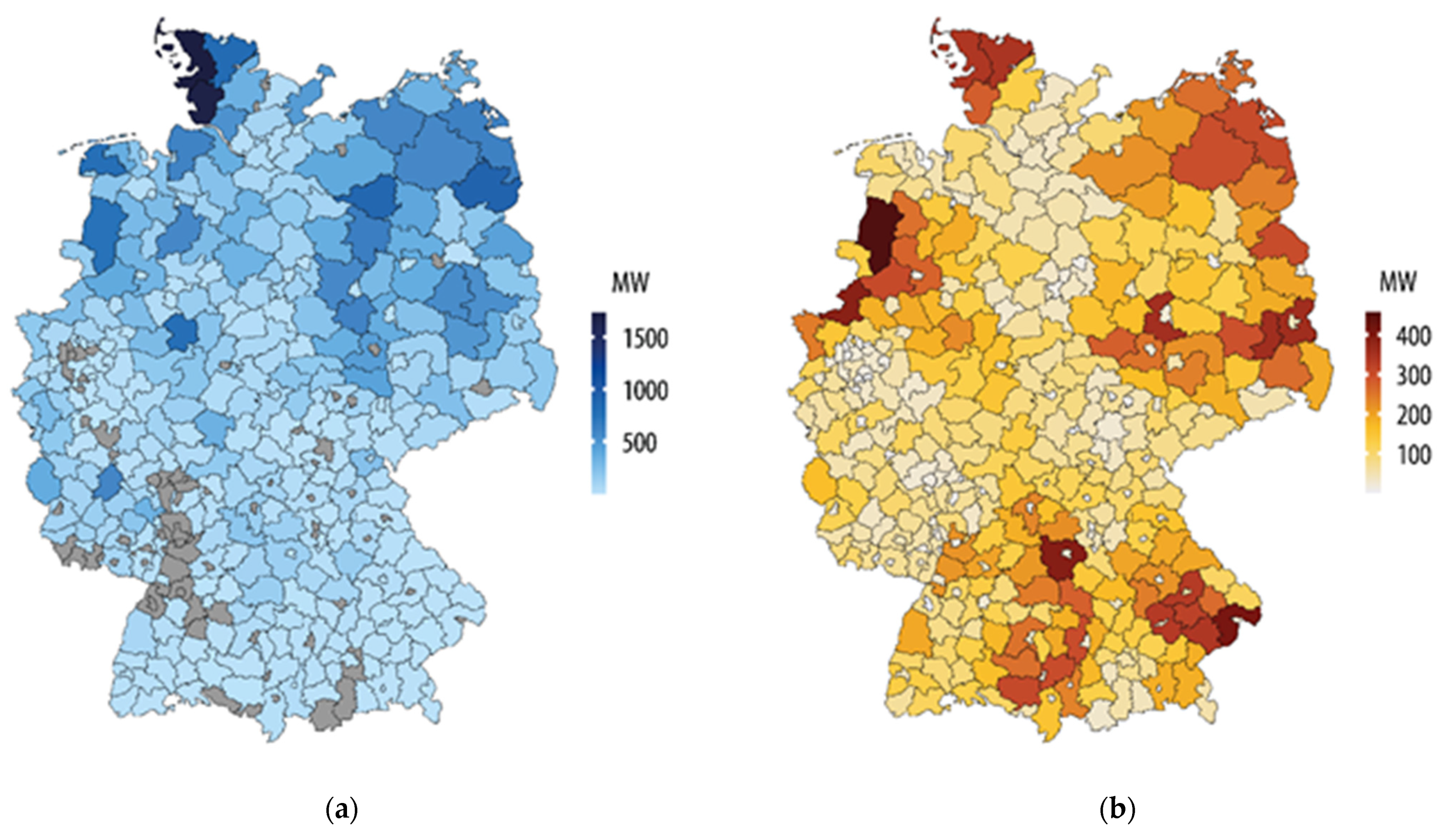

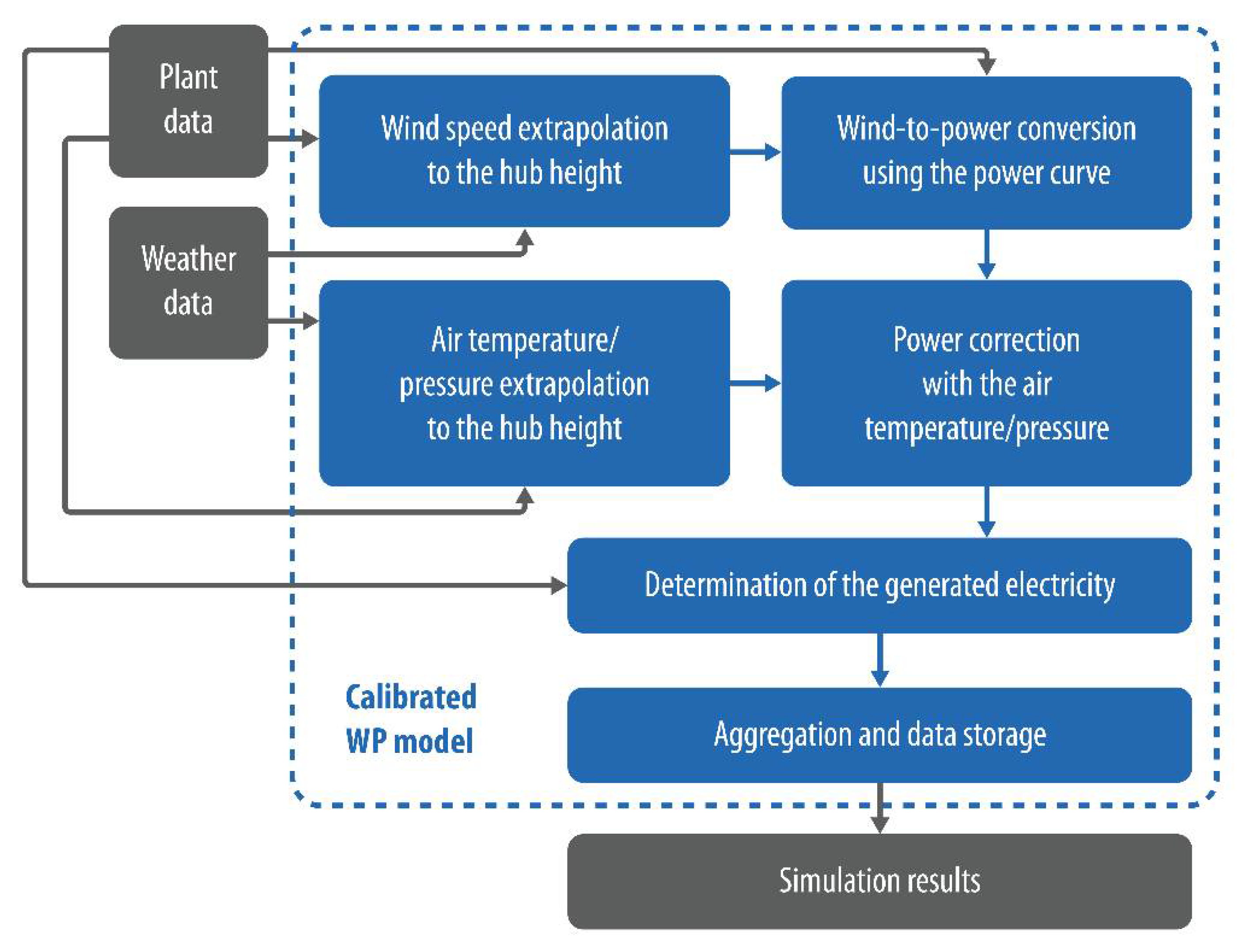
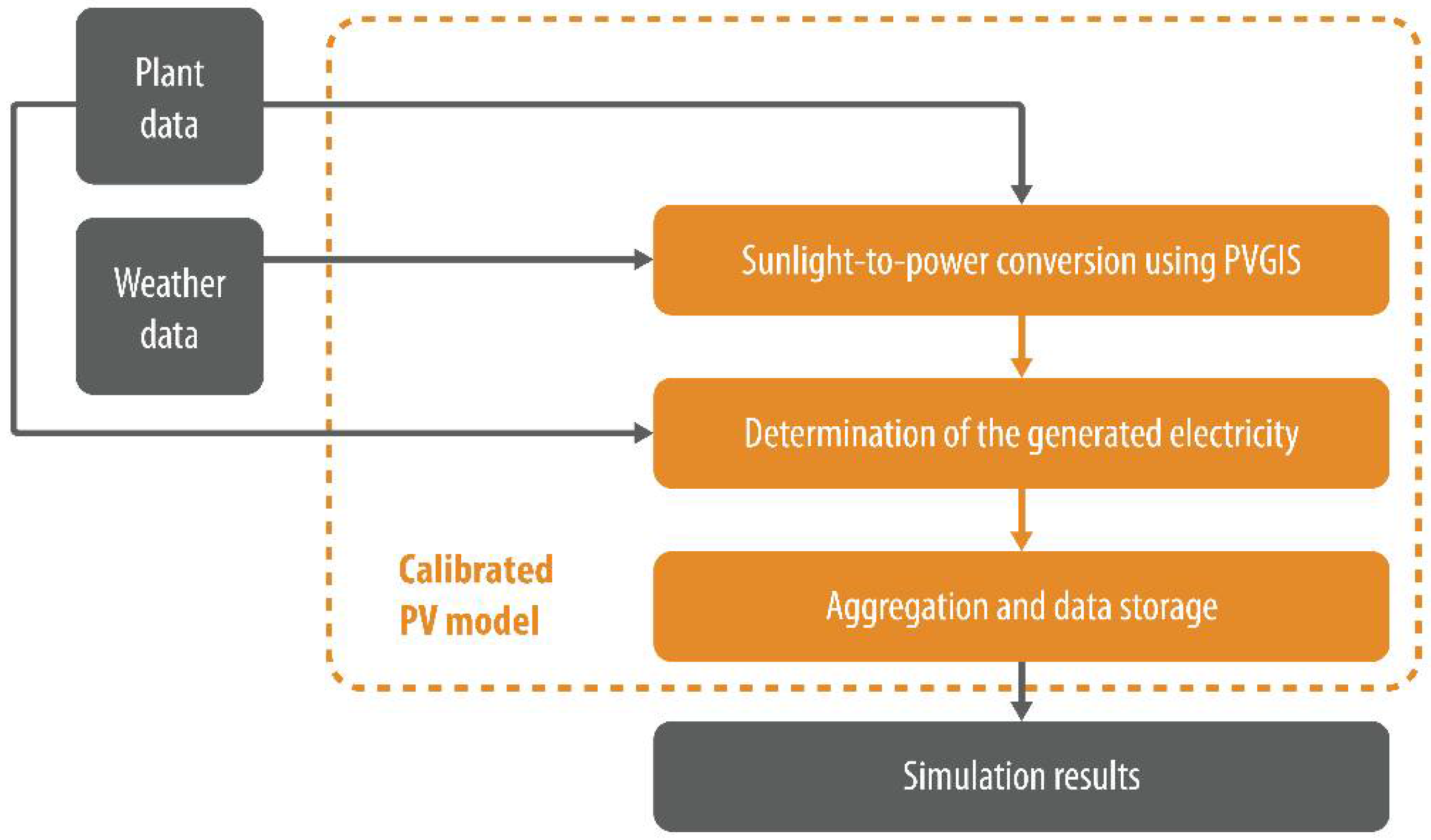
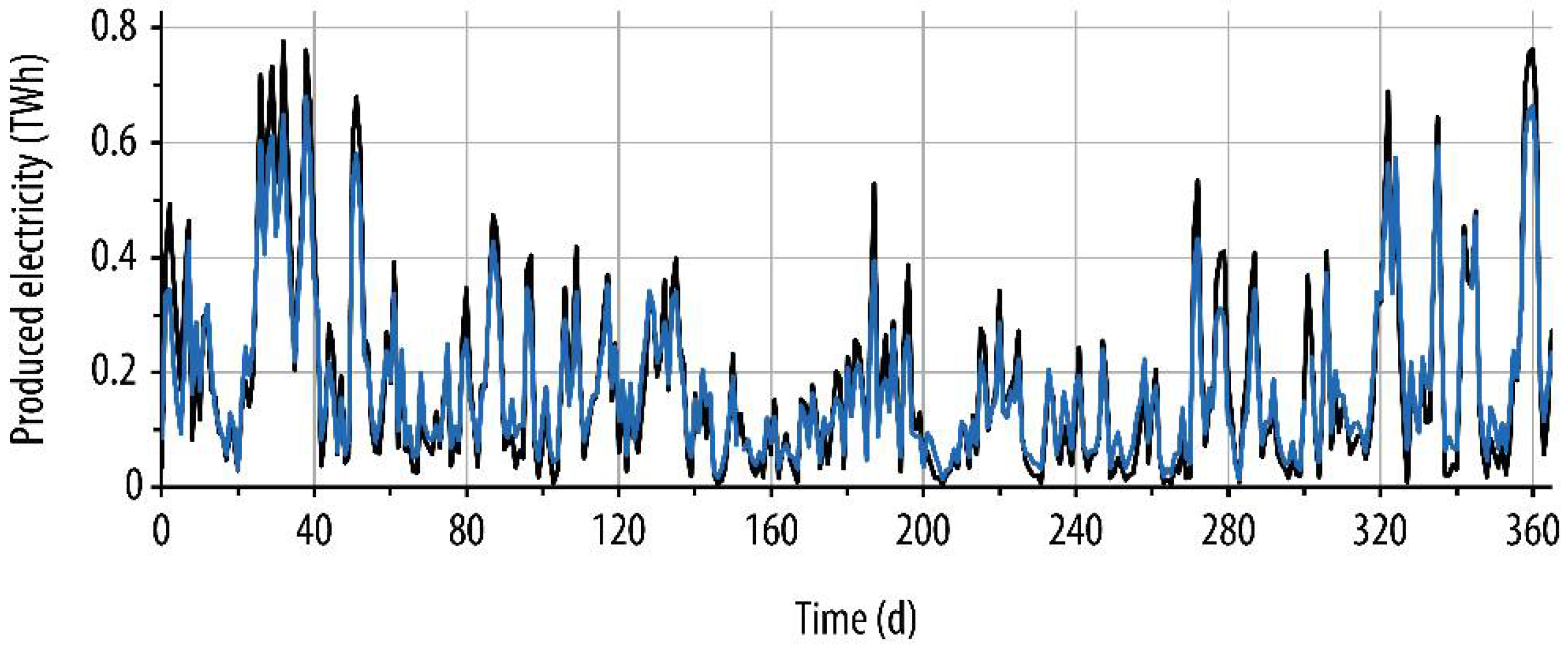
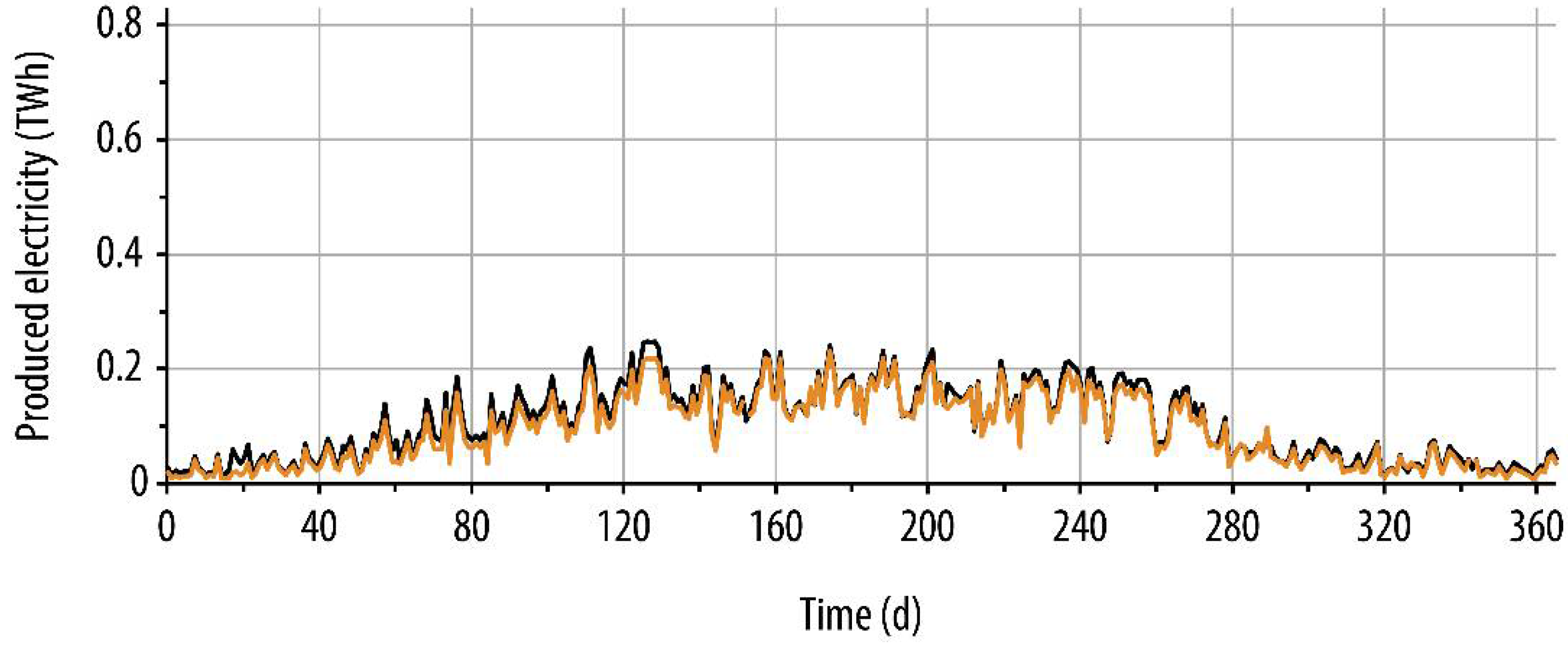

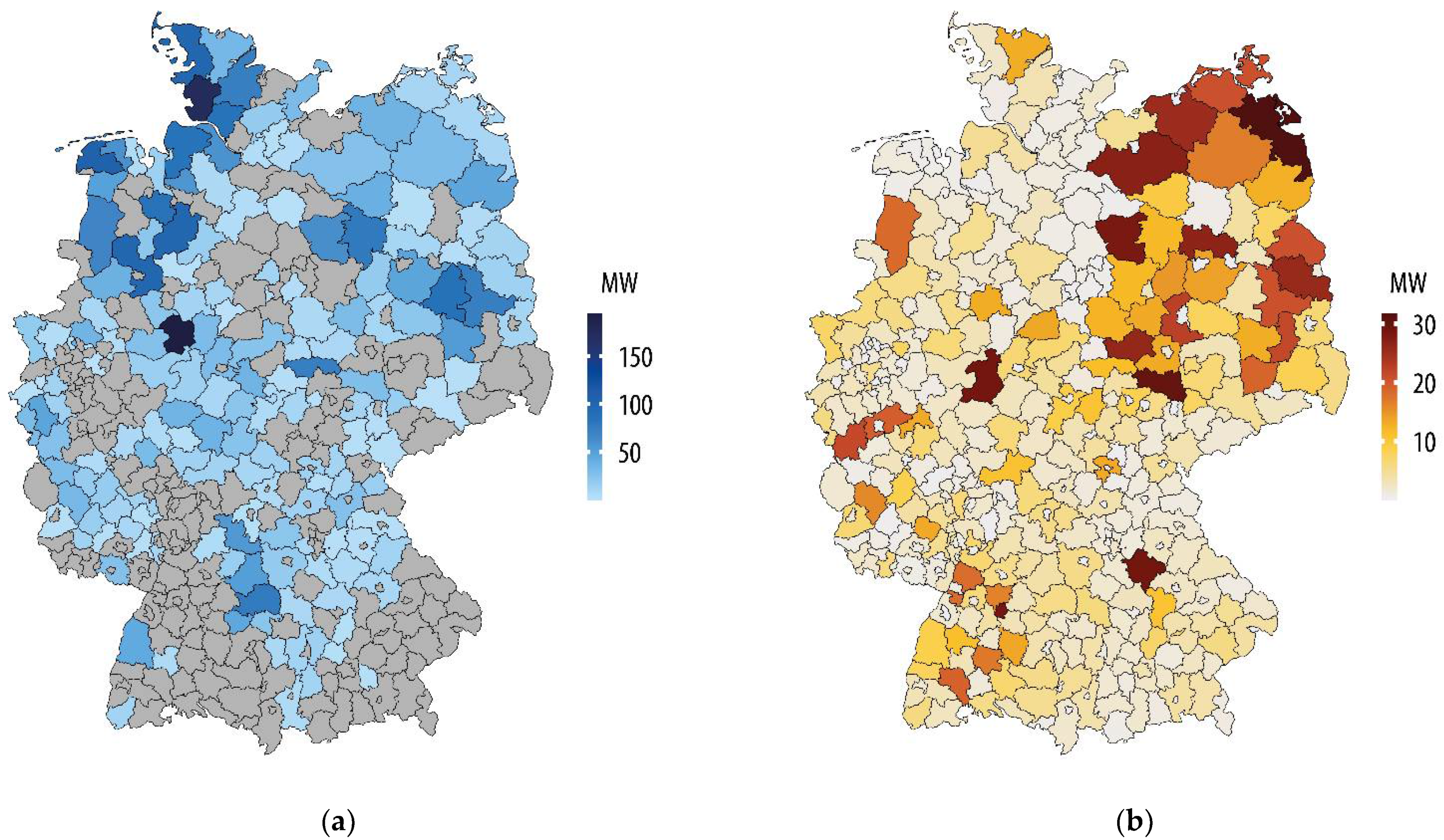
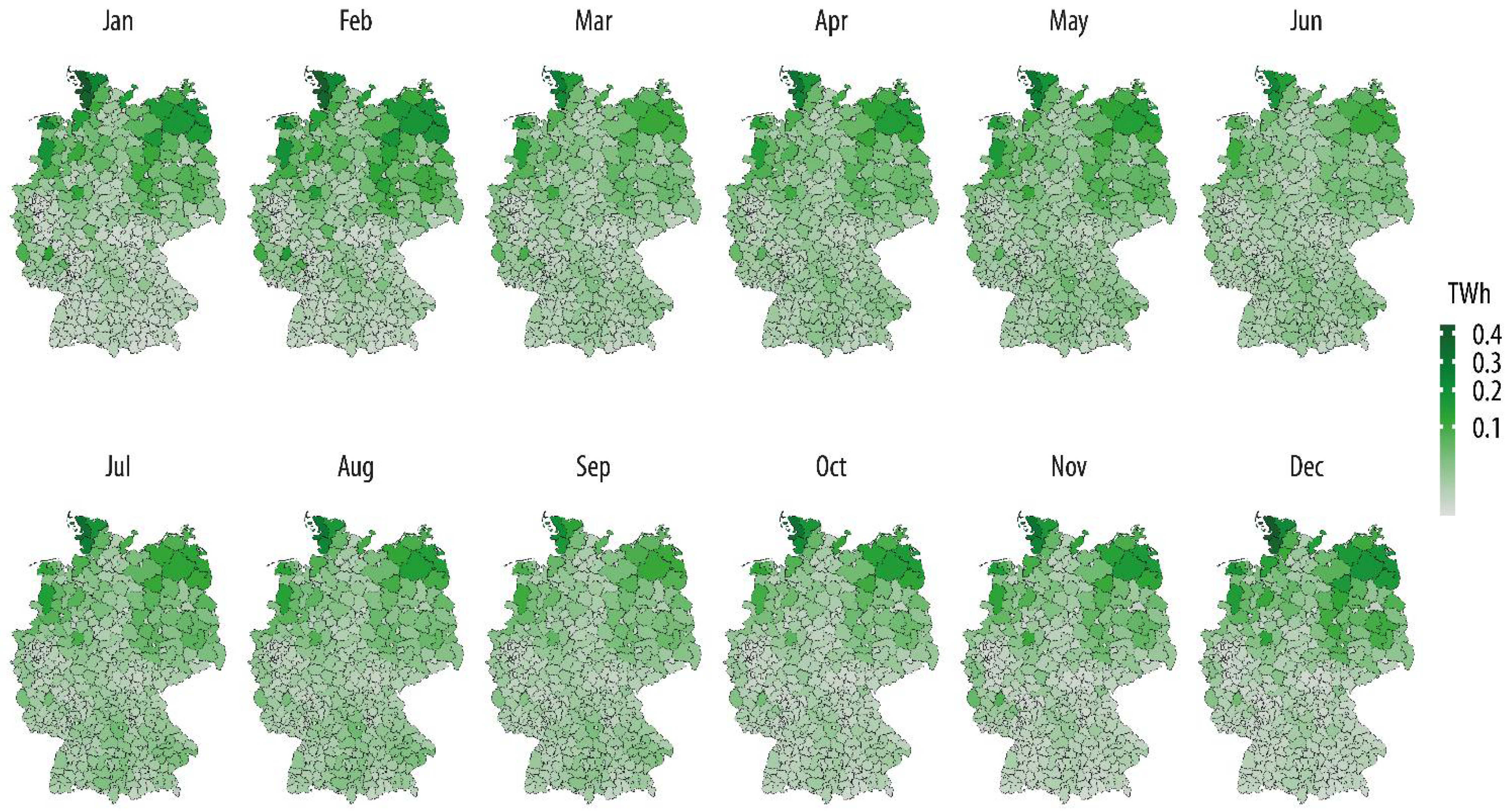

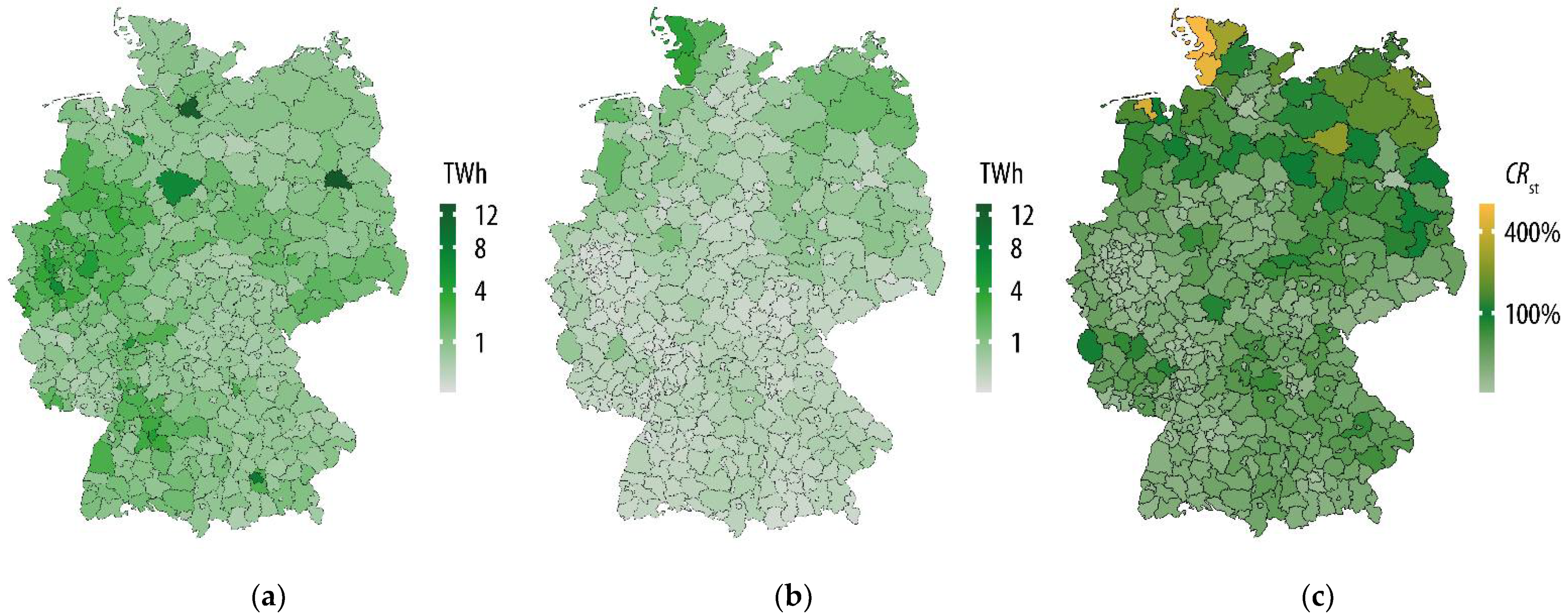
| Parameter | Wind Power Model | Photovoltaic Model |
|---|---|---|
| Latitude | required | optional |
| Longitude | required | optional |
| LAU-Id 1 | optional | required |
| Commission date | required | required |
| Decommission date | optional | optional |
| Rated power | required | required |
| Hub height | required | not applicable |
| Rotor diameter | not applicable | not applicable |
| Turbine type | optional | not applicable |
| Power Class (kW) | Turbine Type | Power Range (kW) |
|---|---|---|
| 100 | Fuhrländer FL100 | PR ≤ 150 |
| 200 | Enercon E-30 | 150 < PR ≤ 250 |
| 500 | Enercon E-40 | 250 < PR ≤ 750 |
| 1000 | Vestas V52 | 750 < PR ≤ 1500 |
| 2000 | Enercon E-82 | 1500 < PR ≤ 2500 |
| 3000 | Vestas V112 | 2500 < PR ≤ 3500 |
| 5000 | Enercon E-126 | PR > 3500 |
| Data | Onshore Turbines | Photovoltaics | Common Values |
|---|---|---|---|
| Installed capacity | 45.3 GW | 40.7 GW | 86.0 GW |
| Feed-in | 64.0 TWh | 33.9 TWh | 97.9 TWh |
| RMSE | 45.6 GWh | 13.9 GWh | 46.5 GWh |
| RMSE/Feed-in | 0.07% | 0.04% | 0.05% |
| R-value | 0.97 | 0.97 | 0.96 |
Publisher’s Note: MDPI stays neutral with regard to jurisdictional claims in published maps and institutional affiliations. |
© 2022 by the authors. Licensee MDPI, Basel, Switzerland. This article is an open access article distributed under the terms and conditions of the Creative Commons Attribution (CC BY) license (https://creativecommons.org/licenses/by/4.0/).
Share and Cite
Lehneis, R.; Manske, D.; Schinkel, B.; Thrän, D. Spatiotemporal Modeling of the Electricity Production from Variable Renewable Energies in Germany. ISPRS Int. J. Geo-Inf. 2022, 11, 90. https://doi.org/10.3390/ijgi11020090
Lehneis R, Manske D, Schinkel B, Thrän D. Spatiotemporal Modeling of the Electricity Production from Variable Renewable Energies in Germany. ISPRS International Journal of Geo-Information. 2022; 11(2):90. https://doi.org/10.3390/ijgi11020090
Chicago/Turabian StyleLehneis, Reinhold, David Manske, Björn Schinkel, and Daniela Thrän. 2022. "Spatiotemporal Modeling of the Electricity Production from Variable Renewable Energies in Germany" ISPRS International Journal of Geo-Information 11, no. 2: 90. https://doi.org/10.3390/ijgi11020090







